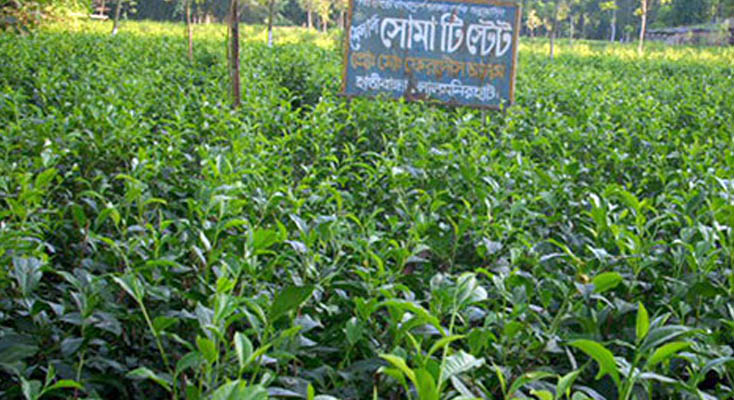The Dhaka Times Desk The unexpected success of tea cultivation in the vast wastelands of the northern border districts of the country opened a new horizon. It is possible to earn thousands of crores of rupees by cultivating tea here.

The potential of tea cultivation in the northern region has added a new dimension to the national economy of the country. These regions in the north are called the third tea region of the country. Thousands of acres of tea plantations have transformed the northern region into an industry. Prominent economists of the country have also expressed the opinion that it is possible to earn several thousand crores from the northern region by cultivating tea. Due to this, the number of tea gardens in northern areas suitable for tea cultivation is increasing day by day. Due to the demand, the price of arable land has also increased manifold.
Among the lands suitable for tea cultivation in the border areas, the highlands of Panchagarh are the best. Due to this, tea has been cultivated on about 2 thousand acres of land in Panchagarh district alone. If economic support and government support is provided to this potential industry, tea production from here will be a milestone in the national economy. Raw leaves produced in 236 gardens in Panchagarh district are being processed and marketed by the two tea factories of Panchagarh, TTCL and Karatoa. Although the small tea farmers have been demanding the government to increase the price of their raw leaves. However, local traders said that the demand of farmers to increase the price of tea leaves is still ignored. The scope of tea cultivation in this region has not increased due to various complications in obtaining credit, fertilizers and pesticides and required materials on easy terms including not determining the fair price of tea leaves. It is possible to cultivate tea in 39 thousand 500 acres of land in Panchagarh. Among these lands, 11 medium and 18 large tea gardens have been developed on 1,680 acres of land, according to which high quality tea is produced in most of these lands. Domestic tea demand of the country is increasing at the rate of 3.5 percent every year. But the production of tea is not increasing even half of that.
According to local sources, tea cultivation has started in Panchagarh for about 5 years. According to the survey of the tea board, 16 thousand hectares of land is suitable for tea cultivation in this area. However, in the 5-year program adopted by the Tea Board from 2002 to 2006, tea cultivation was planned on 300 hectares of land at the initial stage, but in fact, information has been found that tea cultivation has already been done on 1200 acres of land. However, the special difference between tea cultivation in Sylhet and Chittagong region is that all the land in this area is privately owned. That is why tea cultivation here is mainly on a small scale basis. One plantation called Kazi & Kazi Tea Estate has a somewhat larger scale of tea cultivation, while the other plantations are under 150 acres. Even the small farmers themselves have developed small scale tea plantations on their land. Farmers are now benefiting more financially due to better production of tea compared to other crops. The meeting of the tea board also proved that not only Panchagarh but also the neighboring district Thakurgaon and some other areas have suitability for tea plantation.
In Panchagarh tea cultivation has been mainly done in two ways. First organically, secondly on a small scale basis. In 2000, Kazi Shahed Ahmed, the leader of Kazi & Kazi Tea Estate, started tea cultivation on only 33 acres of land. Now this cultivation has reached 1 thousand acres. Kazi Tea Estate mainly aims to bring under cultivation the vast waste lands of Panchagarh. Now not only Kazi Tea Estate, hundreds of tea gardens have been developed in Panchagarh. Tea has been cultivated on a large scale in the Sylhet, Srimangal, Chittagong regions of the country since a long time ago. All these plantations have their own processing factories. Tea cultivation in Bangladesh started about 150 years ago. The tea produced in the country meets the domestic demand and is also exported to foreign countries and a huge amount of foreign exchange is earned by exporting about 25 million kg of tea annually. But this situation is getting worse day by day. Because the domestic demand of tea is increasing at the same rate as the production of tea is not increasing. And for these various reasons, with the aim of increasing the production of tea in the country, tea board has taken initiatives to identify new areas suitable for tea cultivation and to expand tea plantations.
Until now, tea was being cultivated in large plantations in the hilly areas of the larger Sylhet and Chittagong districts of the country. Through the tea board survey it is confirmed that there is suitability for tea cultivation in different areas of Panchagarh district. The soil and climate here are very suitable for tea cultivation. Its practical proof is that tea is being cultivated extensively in the bordering Indian areas. The farmers of that region believe that these areas bordering the northern region can be a milestone for tea cultivation if they get the necessary support.
References: Monthly Development Economics


